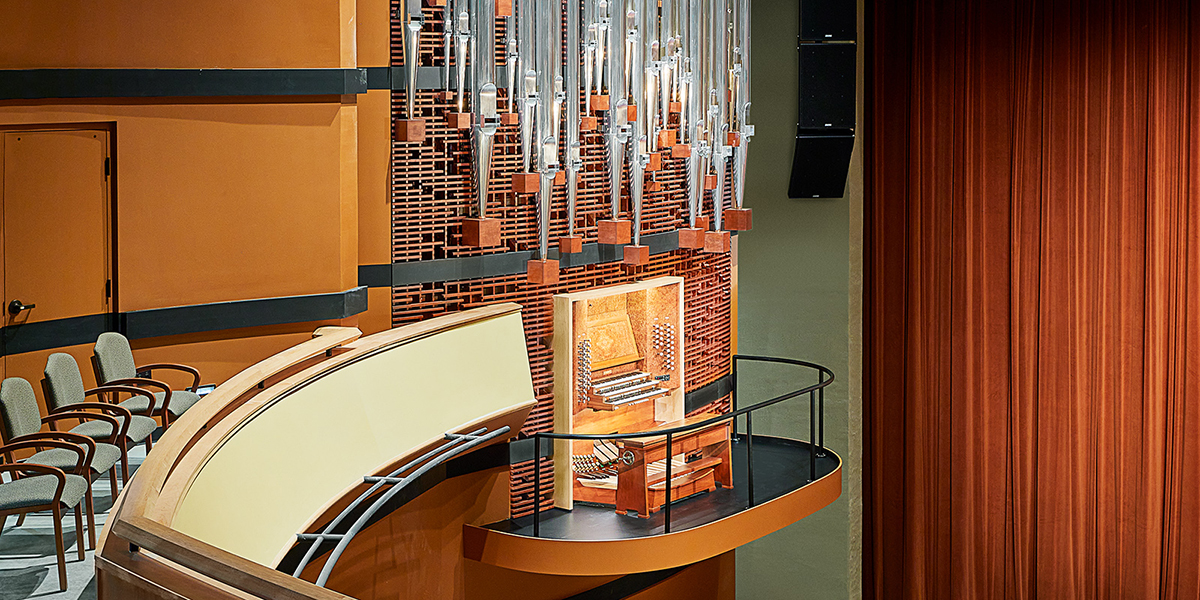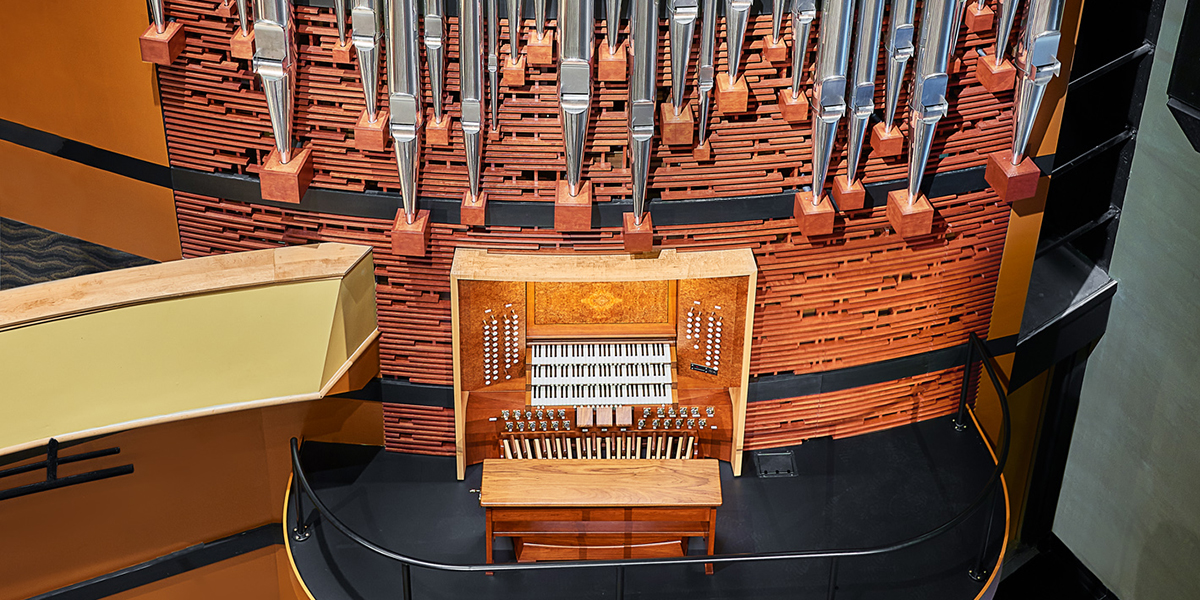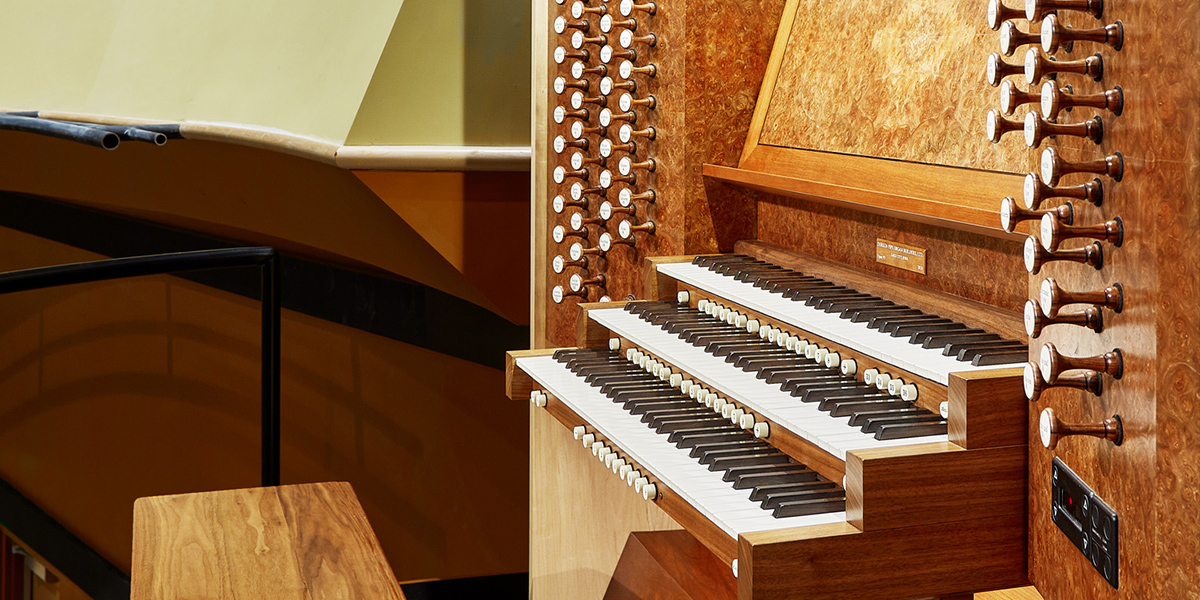
John and Alice Butler Pipe Organ
Opus 97

John and Alice Butler Pipe Organ
Opus 97

John and Alice Butler Pipe Organ
Opus 97
In addition to all of the architecturally unique aspects to Heritage Center, this multi-purpose performing arts facility is one of the few to also have a pipe organ that is located in John and Alice Butler Hall. The John and Alice Butler Pipe Organ as installed and officially debuted on April 6, 2021 at the Dr. Charles Barland Organ Recital
Fast Facts
Gift Of:
UD Trustee John Butler (DHL '17) and his spouse, Alice (DHL '17)
Designer, Builder, and Installer:
Dobson Pipe Organ Builders, Ltd.
Lake City, Iowa
Designated By Dobson As:
Opus 97, as it is the 97th new organ built by the firm
Acoustical Design:
Threshold Acoustics
Chicago, Illinois
Features
- Total Pipes: 3,033
- Largest Pipe: 32 feet long
- Smallest Pipe: Half the size of a pencil
- Weight of the Organ: 21 tons
- Visible Facade Woodwork: Black cherry with black bands that visually continue the "staff lines" that run around the entire hall
- Organ's Console: Surrounded by naturally-finished hard maple with much of the interior veneered with Carpathian elm burl
- Interior Circular Stair: Allows organist passage through the organ from Heritage Center's third floor to reach the console through a concealed door in the facade woodwork
- Man-Hours: 20 Dobson craftsmen worked approximately 31,000 man-hours over the course of 20 months to build, install, and voice the organ
- The majority of the pipes are installed behind the facade on the left side of the hall, with the largest pedal pipes placed in the hall's acoustically-coupled attic and to the right side of the stage. Though not visible, these bass pipes will be heard with clarity everywhere thanks to an acoustical design by Threshold Acoustics of Chicago.
- The visible pipes are not just for show - they are functional. These speaking pipes are made of an alloy of 85 percent tin with the remainder being lead and some trace elements like copper and antimony to harden the metal. The remaining 3,000-some pipes are made of similar tin-lead alloys or wood.
- Two blowers totaling 10 horsepower supply the organ with the pressurized air or wind needed to play the pipes. These blowers are placed in the basement for sound isolation, and the wind is carried to the organ through large insulated ducts.
- The console is located below the visible pipes. It has three keyboards, or manuals, played by the hands and one keyboard, or pedalboard, played by the feet. These four keyboards control four major groups of pipes, also known as divisions.
- A specially-engineered system of mechanical linkages called the action connects the keys to the valves under the pipes, giving the organist intimate control over how they play.
- Because of their great size or remote location, some pipes are played using a special electrical control system designed to operate simultaneously with the mechanical action. The electrical control system operates on 14-volt DC.
- The organ is the Dobson's 20th organ in the state of Iowa and the largest pipe organ built by the firm in Iowa.
- Founded in 1974, Dobson custom-builds and installs each instrument. Dobson organs can be found in England, Australia, and across the United States.
Timeline:
- 2011: Dobson worked closely with Straka Johnson Architects, UD's design firm, during the design phase of Heritage Center to make adequate preparations for the instrument
- May 11, 2013: Grand Opening of Heritage Center
- 2017: UD Trustee John Butler (DHL'17) and his spouse, Alice (DHL'17) gift the pipe organ
- November 2018 to July 2021: Construction of the organ in Dobson's workshop
- Summer 2019: Prep work in Heritage Center
- July 2020 to August 2020: Physical installation of the organ
- September 2020 to December 2020: Voicing of the organ
- April 6, 2021: Debut of the organ at Dr. Charles Barland's Organ Recital